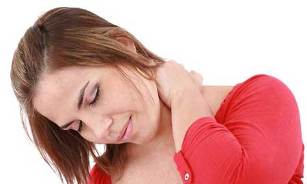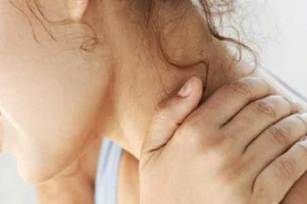In the world there are few diseases that belong to a person only because he is the man. For example, vascular lesions and deposition on their walls, cholesterol is also found in the animal world. Symptoms of degenerative disc disease of the neck may be confused with symptoms of other diseases. Increase in blood pressure is characteristic of all warm-blooded animals. Improper nutrition can lead to exhaustion and deficiency of protein and vitamins and chicken, and an elephant, and clam, and the wrestler free style. But osteochondrosis refers to diseases that can be proud only person that even his closest relatives – primates, the disease is almost absent. Let us examine the manifestations of symptoms and treatments for degenerative disc disease of the cervical spine.

Cervical degenerative disc disease, is it?
Osteochondrosis of the cervical spine — a disease of the bone and cartilage that belong to the dystrophic — degenerative. The underlying disease (malnutrition cartilage), and then its destruction or degeneration. In fact, osteochondrosis primarily suffer intervertebral cartilaginous discs, and then "snowball" is supplemented by the reaction of bone (osteophytes), the appearance of protrusions and hernias of root symptoms, the occurrence of instability in the cervical spine, as well as severe headaches and chronic muscle spasm of the deep muscles of the neck with the disorder of regional blood flow. The cause of osteochondrosis of the intervertebral discs in the cervical or cervical – thoracic only one: it is historically established vertical position of the person. No cats or cows or hippos there are no such constant axial load in vertically located the back, the spine is in a relaxed, "loose" state, and intervertebral discs feel comfortable. The person also to the development of cervical degenerative disc disease predispose such factors:
- Often being in a vertical position;
- Injuries and rapid movement, head shots, e.g., low ceilings;
- The carrying goods on their shoulders, in some countries – on the head;
- The lack of active movement. It leads to weakness of the muscular system, which is critical in the cervical spine.
Also, additional factors include wearing in winter, heavy collars and fur hats with the aim of "pleasing fashion", reduced fluid intake, causing dehydration of primary cartilage. This increases the fragility of the discs and causes their settling" (narrowing thickness), reducing the elastic buffer properties. In his youth, to the degenerative disc disease may result in the violation of posture during writing assignments and working at the computer. Congenital changes in the spine, for example, scoliotic deformity in the thoracic spine. Remember — the higher is the spine, the stronger the impulse, which can have a detrimental effect, by analogy with "whiplash" injury. Therefore, the failure or violation of compensatory mechanisms that protect our skull from too much hot, also leads to degenerative disc disease of the cervical spine. Here are the reasons:

- Flat feet, both longitudinal and transverse. The arch of the foot, deprived of his depreciation, unable to keep the intervertebral discs of the cervical from concussion and fracture;
- Underlying degenerative disc disease of the lumbar spine. If the elasticity in the lower back is broken, do not expect good protection against cervical.
Symptoms of degenerative disc disease of the cervical spine
Signs of osteochondrosis of the cervical spine are very diverse, but all of them can be divided into local and remote displays. Local symptoms of cervical degenerative disc disease include:
- Pulling and muscle pain aching, low intensity, worse after prolonged sitting, for example, when working in an office behind a computer.
- Crunching when moving the neck. Most strongly it is felt when performing morning exercises, in that case, if the plug fingers in his ears. Then bone conduction sound exceeds the air, and when turning neck crunch is heard well. This symptom indicates the appearance of osteophytes which violate the congruence (fitting accuracy) of the cartilage and vertebrae;
- Pain in the neck, both when driving (mostly sharp). These pains are called Servicio, by analogy with "lumbago" in the back, which is called lumbago. Such pain treat radicular manifestations of osteochondrosis. They arise when a sudden concussion of the nerves that occurs with laughing, coughing, sneezing, straining. This pain reminds neuralgia, and similar to an electric shock in its power and suddenness. Most often it occurs in the thoracic spine;
To remote signs include:
- Headaches osteochondrosis. Occur quietly, reminiscent of the "helmet" or "helmet", are often symmetrical. The intensity is low, they may be associated with the movement, but not necessarily. Often they "go" to the head, neck, and accompany a sedentary lifestyle.
- Conductive disorders of sensitivity. Often arise at night – waking up, the person feels that he has numb fingers. Most often it is the little finger and half ring finger on the side of the little finger. To restore sensitivity, you need to move your arms, neck and change position.
This is due to the pinching of the roots of the cervical plexus in the places of output of nerves. It is important that the roots are mostly restricted to spasserovannye neck muscles, which are adjacent to the vertebrae. Cervical degenerative disc disease, symptoms of which we have considered, may be complicated by instability of the cervical spine. The height of all intervertebral discs in the cervical spine is uniformly reduced, and the necks are "abnormal mobility", or the tendency to pain and different strains in the movement. When this condition occurs frequent appearance of pinched nerve roots and increases the risk of protrusion and hernia.

The role of muscle spasm
There is a secondary muscle spasm, which is called myofascial — tonic syndrome. This condition can occur in different parts of the spine, anywhere where there is striated muscle. By reducing the height of the intervertebral disks and the growth of marginal osteophytes, muscles and their blood supply is deteriorating. Accordingly decreases and the venous outflow. Such a situation leads to swelling of the muscles and their chronic spasm, which presents with pain and stiffness in the neck and back.
Diagnosis of osteochondrosis of the cervical
In typical cases, the degenerative disc disease of the cervical spine occurs with the above symptoms. Therefore, the main stage of diagnosis has been and remains the identification of the patient, establishing the presence of muscle spasm associated with simple palpation of the muscles along the spine. To confirm the diagnosis of osteoarthritis using radiographic studies:
- X-rays of the cervical spine with functional tests in flexion – extension is not showing cartilage, as tissue transmits x-rays.
Despite this, the location of the vertebrae is possible to draw General conclusions about the height of intervertebral disks, in a General straightening of the physiological curve of the neck – lordosis, and the presence of the regional growths on the vertebrae during prolonged irritation of their surfaces fragile and dehydrated intervertebral discs. Functional tests allow to confirm the diagnosis of instability in the cervical spine;
- Magnetic resonance and x-ray computed tomography is shown to clarify the internal structure of the cartilage and the formation of protrusions and hernias.
So accurately exhibited the diagnosis of complications of the disease, and the result of the scan is an indication for operative treatment of hernia in the neurosurgery Department.
Treatment of cervical degenerative disc disease, drugs
Treatment of degenerative disc disease of the cervical spine has always been complex: first, remove acute pain with drugs, then, when cervical osteochondrosis (pain decrease) regresses, join physiotherapy and massage techniques, and after cupping this acute phase starts secondary prevention, that its aim is the prevention of re-exacerbations. Sometimes the patient is assigned to a Spa treatment. The main groups of drugs for the relief of acute pain is:
- Nonsteroidal anti-inflammatory drugs. Inhibit the inflammatory component;
- Muscle relaxants Central action . Reduce the tone of spastic muscles, reducing pain, stiffness in muscles;
- B vitamins contribute to the improvement of the trophic nervous tissue;
- Drugs to improve capillary blood microcirculation — improve outflow and normalize the function of muscles.
These funds are assigned to, or inside, or intramuscular injection for greater efficiency. The purpose is to relieve acute pain. Then after 2-3 days go to the reception of tablets, actively apply ointments or gels that are rubbed into the neck and back. In the second stage join physiotherapy – electrophoresis with vitamins and hydrocortisone, massage, underwater traction and power shower, iglorefleksoterapevta techniques. Sometimes prescribed drugs – chondroprotectors, but when taking them inside their efficacy is still not proven. Only intra-articular introduction of substitutes of the synovial fluid can reduce the crunch to facilitate movement and eliminate pain. But in osteochondrosis, this technique worked on large joints, is almost never done. Surgical treatment is carried out in severe compression protrusion or hernia of the sensory or motor root. The indications for surgery are intractable pain expressed in the course of a month, not amenable to treatment or progression of weakness in the muscles of the arms, extension of reduction of sensitivity, and confirmation of the diagnosis of protrusion and herniation by MRI or CT.
Exercises with cervical osteochondrosis
Gymnastics in osteochondrosis of the cervical spine is not that other, as a rational adherence to physical activity and healthy lifestyle: the osteochondrosis is found in all without an exception of people, starting from childhood, and even in some places it is considered a normal variant". Because there is no such person, especially in adulthood would not have signs of degenerative disc disease, the goal of gymnastics is to leave only the objective radiological signs of the disease, and to eliminate all complaints. It is known that even elderly and old people can not make a complaint on his neck and back, but only if you have enough time prevention.
Prevention of cervical degenerative disc disease
Perhaps, for example, degenerative disc disease can bring the principles of prevention, which are shown to everyone, and as a result we get rules of a healthy lifestyle. Here they are:

- Free movement, without extra weights, exercises without load, only with the weight of his body;
- Drinking plenty of pure water, since age causes dehydration of the cartilage tissue;
- The preservation or normalization of body weight;
- A wide range of loads, which reduces the load on the back (swimming);
- Avoiding harmful habits;
- The alternation of mental load with physical. Every hour and a half of mental work is recommended to change the activity to a physical activity;
- Prevent hypothermia of the neck, back, waist, especially in spring and autumn.
Only by adhering to these simple recommendations osteochondrosis of the cervical spine, the symptoms and treatment which we studied, will not bother you for years.































